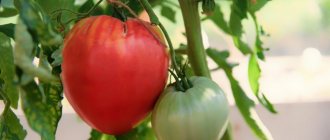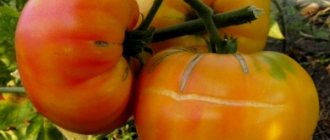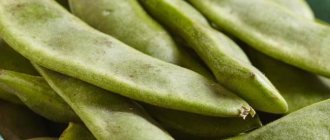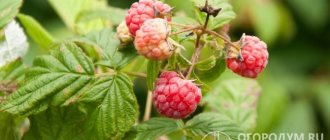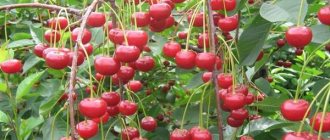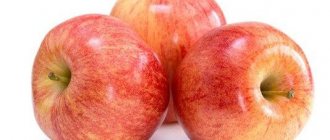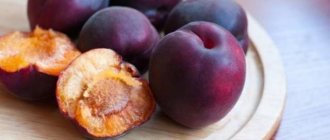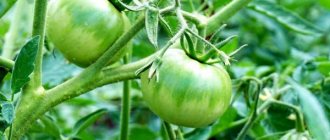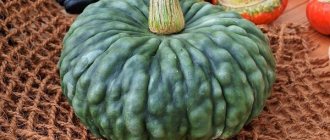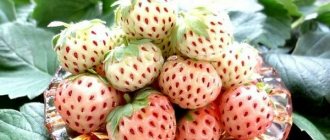- 2.1 Resistance to diseases and pests
Russian pumpkin is a large fruit with a rich aroma, sweet flesh and bright color. The variety is included in the VNIISSOK selection. The vegetable crop has high frost resistance and is therefore suitable for cultivation in the Central regions, including the Moscow region.
There are huge specimens of the Rossianka variety, weighing up to 60 kg. In addition, this pumpkin has a rich mineral composition: fats, proteins, carbohydrates, calcium salts, potassium, magnesium and iron. Microelements – cobalt, copper, zinc. Vitamins – groups B, C, PP, carotenoids.
Characteristics and description of the Russian pumpkin
“Rossiyanka” is a large-fruited, self-pollinating variety of early ripening. Good agrotechnical characteristics have made this pumpkin one of the most popular in Russia.
Brief description of the Russian pumpkin:
- Plant. Climbing, compact. The main stem grows up to 3 m in length. 3 to 4 side branches branch from it. The length of the lashes is 7-8 m. The stem is rounded, covered with hard hairs.
- Leaves. Large, light green.
- Roots. Powerful, go into the ground to a depth of 2.5 m. The roots grow to the sides by 4 m.
- Flowers. Large, yellow-orange in color.
- Fruit. Large, turban-shaped. The bark is fragile, smooth, glossy. The pulp is loose, low-juicy, orange in color, without fibers. The skin and pulp are the same color. The seeds are whitish in color, smooth. The taste of the pulp is sweetish, the aroma is melon.
Growing regions
The “Rossiyanka” variety was bred by Russian breeders specifically for cultivation in unfavorable climatic conditions. The variety was included in the State Register in 1999.
Pumpkin "Rossiyanka" is recommended for the following regions:
- Volgo-Vyatsky.
- East Siberian.
- Central.
- Far Eastern.
The variety is grown almost throughout the entire territory of the Russian Federation - in the North-West, Siberia, and the Urals. Thanks to its early ripening, this variety can be grown in regions with short summers.
Ripening time
Pumpkin “Rossiyanka” is a mid-season variety. The ripening period - from emergence to full ripening - is 90-100 days. Ripening times depend on the time of planting - they are individual for each region.
Productivity
The variety "Rossiyanka" is characterized by high yield. If you properly care for the plantings, you can collect 20-25 kg of fruit from one bush. During large-scale cultivation, up to 30-35 tons of pumpkins are collected from 1 hectare.
The average weight of one fruit is 3.5-4 kg. There are also record-breaking pumpkins - some gardeners managed to grow fruits weighing 30 kg or more.
Resistance to diseases and pests
The “Rossiyanka” variety is characterized by average resistance to diseases and pests. This pumpkin is especially often affected by aphids and fungal diseases, which are combated with chemicals and folk remedies.
Purpose of the variety
The fruits are versatile and tasty; they are used to prepare a wide variety of dishes - cereals, juices, salads, soups, and baked goods. The pulp is tender and smells like melon.
The pulp is rich in fats, proteins, carbohydrates, vitamins B, PP, C, and carotenoids. It contains a lot of salts of calcium, iron, magnesium, and contains trace elements - copper, zinc, cobalt. Suitable for dietary purposes.
Description of the variety
The variety is recommended for cultivation in central Russia and the Moscow region. The vegetable is cultivated in greenhouses and open beds; the ripening period is 90-100 days. It does not require special care, so it is great for beginner gardeners.
Distinctive features
The bushes are compact, semi-spreading. The leaf blade is wide, the lashes are of medium length. During the ripening process, many additional shoots are formed that must be removed. The variety rarely gets sick and is resistant to insect pests. The best yield is shown on loose and nutritious soils.
Fruit characteristics and yield
The pumpkins are small, the weight of one varies from 2 to 4 kg. The pulp is dense, sweet, with a melon aroma. The surface is smooth, the color is orange. The taste and product qualities are excellent; the Rossianka variety is universal in use. From 1 sq. m, gardeners collect about 6 kg of delicious and beautiful fruits.
Interesting! Pumpkin is 90% water and contains beta-carotene, which is beneficial for human health. This powerful antioxidant neutralizes the negative effects of free radicals and protects the body from premature aging.
Advantages and disadvantages of the variety
The advantages of the “Rossiyanka” variety include:
- Consistently high yields.
- Excellent taste.
- Long-term storage.
- Pleasant taste and aroma.
- The fruits are the same size.
- Disease resistance.
- Tolerates transportation well.
This variety has practically no disadvantages, except that substandard seeds are often found - empty or deformed.
Description and characteristics of the variety
This pumpkin variety is actively grown in rural farmsteads and farms thanks to:
- high yield;
- early achievement of ripeness;
- cold resistance;
- large-fruited;
- high taste qualities.
The characteristic external features of the “Russian woman” can be judged from this table:
| Fruit size | Large |
| Fruit shape | Pear-shaped |
| Leaf Shape | Medium size, shaped like a kidney; light green color. |
| Color | Bright orange |
| Flowers | Yellow |
| Seeds | The seeds are large, with a gray-white skin and a rim on the sides of the seeds. |
| Peel | The surface of the pumpkin is externally smooth, with a glossy sheen. The bark of ripe fruits is soft and of medium thickness. |
| peduncle | Round, finely ribbed |
| Root | Branched, up to 3 m. |
Cultivation
Pumpkin is grown in two ways - seedlings and direct sowing of seeds in the ground. The seedling method is popular in regions with late spring and short summer. The second option, sowing into the ground, is used mainly in the southern regions of the Russian Federation.
Timing of sowing seeds
The timing of sowing seeds depends on the climate zone and method of cultivation:
- Seeds are sown at soil temperatures from +15 °C. At lower temperatures, seeds will not germinate.
- Seeds for seedlings are sown so that after 20-25 days they can be planted in open ground.
- In the middle zone, sowing begins in mid-May, in regions with a more severe climate - in the last ten days of May. In the southern regions, sowing is carried out in April.
Seed preparation
Pumpkin seeds have a very dense shell, so it is recommended to soak them before planting:
- Wrap the seeds in a cloth dampened with water.
- Moisten the fabric from time to time. Temperature: room temperature.
- When the seeds hatch, place them in the refrigerator. This will be a good hardening, increasing the resistance to cold in adult plants.
Growing seedlings
Due to the sensitivity of the roots, pumpkin does not tolerate transplantation well. To relieve the plant from stress, its seedlings are grown in peat pots with a diameter of 10 cm, then the seedlings are moved into open ground along with the container.
When buying peat pots, pay attention to their composition - it should be indicated on the packaging. The product must contain at least 50% peat. If the pots are cheap, they contain compressed paper. Seedlings grow poorly in fake pots and often die when transplanted.
If there are no peat pots, prepare ordinary containers. They are filled with purchased universal soil or a mixture of peat and sand (1:1) is prepared. No fertilizers are needed.
The procedure for sowing and growing pumpkin seedlings:
- Moisten the soil before planting.
- Plant 2 seeds in each pot. Bury them 2 cm, cover them with soil and compact them so that the seeds do not germinate along with the shell, which interferes with the development of the seedlings.
- Cover the pots with something transparent - film, glass. The optimal temperature is from +23 to +25 °C.
- When the shoots appear, on the 4-5th day of sowing, choose the strongest of the two. Remove the second one.
- Remove the film/glass and lower the air temperature to +18-+20 °C so that the sprouts do not stretch and the root system develops intensively.
- Water the seedlings as the soil dries out. The approximate frequency of watering is once a week.
- A few days after germination, the temperature must be increased again, to +20-+22 °C.
- After 20-25 days, if weather conditions permit, the seedlings can be planted in the ground.
In order for the seedlings to grow better, they are fed several times. First, liquid organic fertilizers are applied, then mineral fertilizers.
Soil preparation rules
Pumpkin loves loose, fertile, well-warmed soil. The culture grows worst on damp clay and acidic soils.
Soil preparation procedure:
- In the fall, dig up the area prepared for planting pumpkins. Digging depth – 20 cm.
- Add 5 kg of humus, 30 g of superphosphate and 15 g of potassium chloride per 1 square meter for digging. m. If there is no humus, it can be replaced with manure (per 1 sq. m - 7 kg).
- To add looseness to the soil, add 1 sq. m a bucket of sand and peat. Add wood ash to acidic soils - about 1 liter.
- There is no need to dig up the soil in the spring; just loosen it, remove the weeds and water it with hot water.
- The soil is leveled with a rake in March, and it should remain in this condition until May - before planting the seedlings.
If the soil has not been prepared since the fall, dig it up two days before planting - using half a spade, add 20 g of ammonium nitrate per 1 square meter. m and make holes.
Pumpkin grows well after potatoes, onions, legumes, and root vegetables. It is not recommended to plant it after cucumbers, zucchini, melons and watermelons.
Step-by-step diagram of planting pumpkin seedlings in the ground
Only healthy and strong seedlings are planted in the ground; its signs are:
- stem – short, thick, strong;
- internodes are short;
- three developed true leaves of a rich green color.
Boarding order:
- Dig holes in advance. Depth – 8-10 cm. Between adjacent holes – 80 cm. Distance between rows – 1.5-2 m.
- The day before planting, water the seedlings to make them easier to remove from the glasses. If the seedlings are grown in peat pots, it is not necessary to water them in advance.
- Start planting in the evening. Carefully remove the seedlings from the planting containers and transplant them into the holes. Be careful not to damage the roots. Move seedlings in peat pots into holes along with the container.
- Bury the seedlings down to the cotyledon leaves.
- Pour generously with warm water.
- Sprinkle with soil and mulch with hay dust, straw chaff, sawdust.
- Make edges around the holes to prevent water from spreading when watering. Some gardeners use old tires instead of sides.
- If you are not sure about night temperatures, cover the plantings with film until stable heat sets in.
Planting seeds in open ground
To plant pumpkin seeds in open ground, the holes are prepared according to the same scheme as for seedlings - 80 cm between bushes and 1.5-2 m between rows.
The procedure for sowing pumpkin seeds:
- Pour 5 liters of water into each well. Once absorbed, you can begin planting.
- Place 3-4 sprouted and hardened seeds in one hole. Place the seeds with their noses down.
- Embedment depth is 7-8 cm. If the soils are heavy, the embedment depth is reduced to 4 cm.
- Sprinkle the holes with mulch - humus or peat. Layer thickness – 2 cm.
- To make seedlings appear faster, cover the plantings with film with small slits. At the same time, the shelter will protect the crops from frost.
- When the shoots appear, remove the excess ones - you should leave only one sprout per hole, the strongest and healthiest.
Corn and legumes can be planted next to the pumpkin. But zucchini and cucumbers are planted as far as possible, otherwise cross-pollination will worsen the taste of the fruit.
Rules of care
Pumpkin requires minimal care, but to get a good harvest, you should follow these recommendations.
Watering
The plant requires a large amount of water. As a result of the fact that pumpkin has large leaves, moisture evaporates quickly, which, if it is deficient, can lead to drying out of the plant. Therefore, it is necessary to regularly water the pumpkin with enough water.
Up to 30 liters of water are needed per 1 square meter. The water should be settled and warm. Watering is carried out at the root. Avoid getting water on leaves and stems.
Weeding and loosening
Weeding and loosening are carried out as the weeds grow. While the leaves are small, actions are carried out once a week. As soon as the fruits appear, you can only remove the weeds.
Top dressing
The first fertilizing is recommended when 5-6 leaves appear on the plant. The next feeding is carried out when lashes form.
As the fruits ripen, fertilizing is then carried out every 2 weeks. During this period, it is necessary to apply mineral and organic fertilizers, alternating them with each other. During fruiting, wood ash diluted in 10 liters of water is added to the root of the plant.
Powder
It is carried out when the pumpkin grows lashes. They must be carefully laid out and lightly sprinkled with soil in several places. Due to this operation, roots will appear on them, which will supply the plant with the necessary nutritional components from the ground.
Caring for Russian pumpkin
The “Rossiyanka” variety is unpretentious and does not require special care. Growing involves performing standard activities. The only nuance in care is the obligatory pinching of the lashes.
Features of watering
Watering is the most important agrotechnical activity in pumpkin care. Large leaves of the plant are a factor that increases moisture evaporation. The plant needs regular watering.
Features of watering the “Rossiyanka” variety:
- Water norm after planting per 1 sq. m – 3-4 l. When the pumpkin begins to grow, the norm increases to 6-8 liters, then to 10 liters.
- If there is no rain, then the frequency of watering is 2 times a week.
- Water the pumpkin only with warm and settled water.
- Water should not get on the leaves and stems.
- Watering is especially important during periods of flowering and fruit formation.
- During fruiting, watering is reduced to once a week. This will allow the fruit to accumulate more sugars and form a strong crust.
Water deficiency leads to crushing of pumpkin fruits.
After watering, the soil is loosened and weeds are removed. Loosening depth is 5-6 cm.
Fertilizing
The amount of pumpkin feeding depends on the soil characteristics. Fertile soil will need two fertilizations per season; depleted soil needs 3-4 applications of fertilizers.
Timing and features of pumpkin feeding:
- The first time fertilizer is applied in the phase of 5-6 leaves. You can feed the plants with vermicompost or any other organic matter.
- The second is during active growth of lashes.
- Further fertilizing is applied every two weeks.
- It is recommended to alternate mineral and organic fertilizers.
- At the beginning of fruiting, wood ash is added. For one hole – 80-100 g.
Applied fertilizers:
- Organic. Thanks to them, the acidity of the soil is reduced and its microflora is improved. 1-2 liters of liquid organic fertilizers are consumed per plant. To prepare the solution, dilute manure, humus or mullein with water 1:10. It is important that liquid fertilizer does not get on the leaves.
- Mineral. It is important to alternate different fertilizers to prevent an overabundance of one or another element. It is recommended to apply mineral fertilizers during flowering and during fruit ripening. Composition of mineral supplements:
- The first mineral supplement is a solution of ammophosphate and urea (15 g per 10 liters of water).
- The second feeding is a complex of superphosphate and phosphate fertilizers. Take 20 g of each product per 10 liters of water.
- The third feeding is a solution of potassium sulfate. 30-40 g are diluted in 10 liters of water.
Formation of bushes
When 1-2 fruits of at least 10 cm in diameter are formed on the main stem, it needs to be pinched. Then the lateral shoots are pinched - their length should not exceed 50-60 cm.
Rules for forming a bush:
- After each fruit there should be 4-6 leaves left.
- For the fruits to be large, no more than 5 ovaries should remain.
- Pinching is done in the morning.
- Tools – pruning shears, knife, scissors.
- At the same time as pruning, the stepsons are removed.
- Excess leaves are removed to avoid shading of the fruit.
Pollination of bushes
If it rains during the flowering period, pollination problems may occur. Then the gardener must help the plants:
- Male flowers are picked.
- Gently touch the male flowers to the female ones.
The male flower differs from the female flower by its tall, thin stem and the absence of a seal – the ovary.
How to harvest and store crops?
Pumpkins are harvested when they reach biological maturity. Harvesting times depend on the growing region and current weather. In most regions, harvest begins in September. The main condition is to remove the fruits before frost.
When cleaning, they focus more on the condition of the pumpkins, rather than on the calendar. The maturity of fruits is determined by their appearance and the condition of the entire plant:
- yellowed and dried leaves;
- dried stalk;
- bright orange peel color;
- hard crust.
Cleaning Features:
- pumpkins are harvested in dry weather;
- the fruits are carefully separated from the stems without damaging the peel;
- stalk length – 5-6 cm;
- Immediately after harvesting, the fruit is dried in the sun, if the weather is good - in the open air, in rainy weather - in a dry room.
Storage conditions:
- Only healthy, undamaged pumpkins are stored for storage. They must have a whole stalk. Specimens with dents and other damage should be consumed as soon as possible - they are not suitable for long-term storage.
- It is best to store pumpkins in a ventilated cellar or basement.
- The optimal storage temperature is from +3 to +10 °C. Humidity – 60-85%.
- The fruits are laid out on shelves or racks with the stalks up - on top of a straw bedding.
- Adjacent pumpkins should not touch each other.
- It is not recommended to store fruits near pumpkins - the ethylene they emit harms the storage of the fruits.
During storage, pumpkin fruits ripen - their sugar content increases, and they taste much better than immediately after harvesting. In “Rossiyanka” the pulp reaches its peak sweetness by December.
Diseases and pests: symptoms, control, prevention
The “Rossiyanka” variety is affected by powdery mildew, anthracnose, root rot, bacteriosis and other fungal diseases. The treatment tactics for all diseases are the same - timely spraying with appropriate fungicides and destruction of the affected parts of the plant.
Diseases and pests of Russian pumpkin:
| Diseases/pests | Symptoms/harm | How to fight? |
| Root rot | Root rot leads to the death of the bush. | Prophylactically spray with a solution of copper sulfate or ash. |
| Tobacco mosaic | Spots on leaves and stems. | Spray with Bordeaux mixture or Fundazol. |
| Bacteriosis | There are spots on the leaves, the fruits are soft. | Spray with copper oxychloride. |
| Powdery mildew | Whitish coating on leaves and stems. | The plantings are treated with Topaz. |
| melon aphid | Pests live in colonies on the plant, sucking juice from leaves, inflorescences and stems. The leaves are twisted, the plant weakens and often dies. | For spraying, folk remedies are used - wormwood infusion, soap solution, onion peel decoction. Or they are sprayed with chemicals - “Karbofos”, “Aktellik”. |
Preventive measures against diseases and pests:
- Pull out weeds in a timely manner, regularly weeding the area.
- Reliable planting material is planted.
- Do not exceed the norm and frequency of watering.
- Avoid overdose of nitrogen fertilizers.
- Maintain crop rotation.
Harvest and storage times
The signal to harvest pumpkins is their biological maturity, which occurs at different times depending on the region of growth. Most often this happens in September. An indispensable condition is the need to do this before the onset of frost.
The biological maturity of pumpkins is indicated by signs in the form of:
- yellowed and dried leaves;
- shrunken and hard stalk;
- bright orange color;
- hardened fruit surface.
We recommend reading how to correctly determine the ripeness of a pumpkin in the garden.
It is preferable to collect pumpkins in dry weather, being careful not to damage the surface of the fruit.
The fruits are collected, leaving a stalk no shorter than 5 cm, and dried indoors or outdoors at a temperature not lower than +25°C. They are then stored in a well-ventilated basement or cellar with a temperature between +3°C and +10°C and a humidity between 65% and 85%.
Pumpkins are stored on straw with the stems facing up, without touching each other. At the same time, it is extremely undesirable to have apples, pears and other fruits stored nearby, as the ethylene released can significantly shorten the pumpkin’s shelf life. If you carefully adhere to all these conditions, pumpkins can retain their valuable qualities until spring.
Possible difficulties
When growing "Rossiyanka" the following difficulties are possible:
- If pinching is not done in time, many small pumpkins appear on the bushes. Due to lack of nutrition, they do not have time to grow or mature. The solution to the problem is the timely formation of a bush.
- If you uncontrollably apply mineral fertilizers, you can harm the plant. Due to an excess of nitrogen, fruits wither, so you need to be careful when applying calcium nitrate, ammonium nitrate and other nitrogen-containing fertilizers. The solution is to alternate organic and mineral fertilizers and adhere to the dosage.
Planting seeds
Large-fruited pumpkin seeds can be planted in two ways.
In open ground
This is usually done in April. You need to make sure that the distance between plants is at least 1 m. Dig a hole 3 cm deep and plant 2-3 seeds there.
Seedling
The procedure is carried out 20 days before planting in the ground.
There are several stages of planting seedlings:
- Soil preparation. It should consist of peat and sand. Before and after planting, the soil is moistened.
- Capacity. It is better to take separate pots. Ideally, they should be made of peat so as not to damage the roots during transplantation. If they are made of plastic, it is better to line the bottom with a layer of sawdust.
- Disembarkation. For seedlings, seeds should be planted 2 per container. Depth – 2 cm.
- Temperature. For 1 week after planting seeds for seedlings, you need to maintain the temperature at about 25 degrees, then reduce it to 18.
- Care. After 2 weeks you need to fertilize. Mullein mixed with water in a ratio of 1 to 10 is suitable.
Planting seedlings
If the seedlings are ready for planting, they meet the following characteristics:
- Stem. Thick and quite strong.
- Leaflets. At least 3-4 strong leaves for each plant.
Rules:
- Before planting, the soil in the garden bed must be watered with hot water;
- a scheme is used, as when sowing seeds, only the holes are dug to such a depth that the root of a plant or a peat pot can be placed in them;
- if the seedlings grew in peat pots, there is no need to remove them, just slightly reduce the volume of the bottom and walls;
- the seedlings should be deepened into the ground up to the cotyledons and watered again;
- To provide protection, the seedlings are covered with film.
Formation of bushes
When forming bushes, adhere to the following recommendations:
- the pumpkin is formed as a single stem;
- to avoid overgrowth, the upper bud is pinched even before the inflorescences appear;
- excess shoots should be removed as soon as they reach 7 cm;
No more than 3 ovaries are left.
Tips from experienced gardeners
Gardeners with experience in growing pumpkins give the following tips for getting rich harvests:
- Reduce soil acidity by adding lime and wood ash.
- Plant only germinated seeds in the ground.
- Plant pumpkins in raised beds above the ground.
- Plant seedlings in calm, cloudy weather.
- Water the plantings with heated water; it should not be colder than +20 °C.
- Spray the plants with whey diluted in water.
A video review of the Russian pumpkin can be seen in the following video:
Reviews
Most gardeners speak positively about the variety. I like its unpretentiousness and high yield even with a minimum of care. Pumpkin is universal in use - it can be baked, boiled, fried, candied fruits and jams, and much more. It has an amazing taste and aroma and is compatible with many products and dishes. The variety can grow vertically. Among the disadvantages, they note that the fruits can spoil early, the seeds inside are empty and swollen.
The pulp of the “Rossiyanka” pumpkin has a melon aroma
Pumpkin “Russian” is a desirable dish on the tables of the inhabitants of our country. Its unique taste gives true pleasure. It has universal use in cooking. At the same time, it is not difficult to care for and always produces an excellent harvest.
Farmers' reviews about the variety
★★★★★
Svetlana, 30 years old, amateur gardener, Belorechensk. The variety is very tasty.
I plant seeds directly into the holes. When baked, it’s like sweet carrots. Pumpkins grow up to 4.5 kg. The bush yields up to 25 kg. Pumpkins can be stored at least until December. ★★★★★
Peter, 45 years old, summer resident, Kashira. I planted pumpkins for the first time, and it turned out to be the “Rossiyanka” variety.
For some reason, the bush took a long time to grow; the fruits began to set only at the end of July. I fed it with mullein and left two vines on the bush - there were 2 pumpkins on each. Grew up to 4 kg. I think that the growth retardation is due to the fact that I did not use superphosphate on time. Hide
Add your review
Growing Russian pumpkin is an activity that does not require a lot of time and money. Large and stable yields, excellent presentation, good shelf life and excellent taste make this variety profitable for cultivation, both for one’s own needs and for sale.
0
0
Copy link
Pros and cons of the variety
- In addition to the above-mentioned advantages, this pumpkin variety also has the following positive qualities:
- ease of care;
- low demands on soil quality;
- good keeping quality, ability to be stored until spring;
- transportability;
- universality of use;
- resistance to most diseases characteristic of pumpkins;
- pronounced melon aroma of pumpkin pulp;
- moderation in the growth of lashes.
- The “Russian” has significantly fewer disadvantages. It is different in this regard:
- with its cold resistance - a pronounced fear of frost;
- with resistance to most pumpkin diseases - sensitivity to powdery mildew.
Growing
The Russian plant is grown both by seedlings and by sowing seeds in the ground. Before this you need to prepare the material. Large, full seeds are selected and prepared for sowing. To do this, it is necessary to use germination.
Selected seeds are soaked in water for 3 hours, then laid out on any wet material and kept at room temperature until they begin to hatch.
To increase resistance to cold weather conditions, the seed material is kept in the refrigerator for 3 to 5 days, and then sowing begins. The planting pattern is 60x60 cm, and deepening into the ground is carried out at a distance of 3-4 cm below the soil surface.
Creating seedlings
The seedling growing method is used to obtain an earlier harvest. To sow the material, special pots are used; pre-prepared soil mixture is placed in them, and then germinated seeds are placed.
After the emergence of seedlings, the seedlings must be properly cared for - watering, loosening the soil and hardening off.
The seedlings are placed in open ground a month after germination. Before planting, you need to make sure that the soil has warmed up to 18 °C. Thanks to this, the plants will grow faster.
Preparing the bed
Before planting the material, the soil is dug up several days before and fertilizers that contain nitrogen are applied. Their quantity should be approximately 20 g per 1 square meter. m of crop area.
Pumpkin is undemanding in terms of soil quality, but in order to get as many high-quality fruits as possible, it should be grown in moist, well-fertilized areas, protected from strong winds and illuminated areas.
Landing
A well-lit area suits the plant
At this stage, the seedlings are carefully removed from the pots and buried up to 5 cm in the holes. The distance between them should be about 60-70 cm. The greater the distance, the better: the fruits are large and heavy and you need a lot of space to expand them.
When sowing in open ground, you should throw 2 seeds into the holes, more is possible, but only after the seedlings will need to be thinned out to prevent excessive density.
Planting and growing Russians
Marble Pumpkin
Pumpkin loves warmth and does not tolerate dampness and cold. It can be grown by seedlings or seeds that are sown in open ground.
The optimal air temperature for growing pumpkin is +25 degrees. Under this condition, it will develop bright, richly colored flesh, juicy and tasty.
Growing
Important! To plant vegetables, you need to select a well-lit, sunny place.
Pumpkin loves moisture. Without it, the fruits will not grow large. If there is a dry summer, the flowers wither and fall off, there will be no ovaries.
How to grow a Russian woman from seeds
To grow a vegetable, it is easier to plant it in the usual way - with seeds. But before landing they need preparation.
First, planting material is selected, in this case seeds. Large, smooth, without visible damage seeds are selected for sowing. Dry and thin ones are not suitable for planting.
Seeds
It is better to germinate the seeds. To do this, they are placed in warm water, approximately 40-45 degrees. The seeds are kept in an aqueous solution for 3 hours.
Attention! To keep the water from cooling down and remain at the desired temperature, you can place a bowl of seeds on a heating device or in a multicooker and turn on the yogurt preparation mode.
The seeds should swell, after which they should be wrapped in a soft cloth and left at room temperature. At the same time, do not forget to regularly wet the cloth, otherwise the seeds may dry out.
Since pumpkin loves warmth, and summers in the middle zone can be cool, the seeds need a hardening procedure. After they hatch, you need to keep them in a damp cloth, but not at room temperature, but on the bottom shelf of the refrigerator for 3 to 4 days.
Hardening of seeds
After hardening, the seeds can be planted in open ground.
Experienced gardeners who have been cultivating pumpkins for more than one year advise planting them with ready-made seedlings.
Growing seedlings
In order for vegetables to ripen earlier and the harvest to please you with quality and quantity, seeds that have hatched and undergone the hardening procedure should not be sown immediately in the garden. What if it's cold? The seedlings will die and may not grow at all. It is safer to grow seedlings from them.
Seedling
To do this, you will need peat pots approximately 10 cm in diameter, since pumpkin seedlings are capricious and do not take root well when transplanted. When transplanted to a permanent place in peat cups, the roots will not be damaged.
Note. Pumpkin cannot be planted often, as one bush will take up to 40 square meters.
You can get a better pumpkin harvest from two plants than from 10 seedlings growing in the same area. Don't chase too many bushes. 2 - 3 is enough.
- You can buy soil for seedlings in a store, or you can prepare it yourself. To do this, mix sand and peat 1:1. There is no need to fertilize with anything.
- Now you need to water the soil in the pot and plant 2 seeds in each. Planting depth is approximately 2 cm. Cover the top of the seedlings with film.
- When the shoots appear, you need to choose the one that is stronger, and pinch the rest and remove the film. Temperatures will drop between 25 and 20 degrees. The seedlings will not stretch upward, and the root system will strengthen.
- After 25 - 27 days, you can transplant the seedlings into the ground into a garden bed.
On a note. Until transplanting, they need to be watered regularly as the soil dries out. No other care required.
Landing in the ground
Be sure to dig up the bed. Pumpkin especially loves places where cucumbers grew before it.
If you decide to plant in a new place, you need to enter:
- humus, at least 3 buckets;
- nitrophoska - approximately 100-120 grams;
- wood ash - a liter jar.
Landing in the ground
Plants should not be planted frequently. The distance between bushes should be at least 75 cm.
Cultivation
Large pumpkin from seeds
Pumpkin seeds have a thick shell, so they need to be soaked before planting.
It's quite easy to do. You need to take a cloth or gauze, fold it in 2-4 layers, wet it, and put all the seeds inside. The seeds should remain in this state until they germinate. All the time you need to make sure that the fabric does not dry out, so it needs to be moistened.
For 3-5 days in the same fabric they are sent to the refrigerator for hardening.
The root system is delicate and does not like transplants. To prevent it from being damaged during transplantation, special peat pots with a diameter of 10 cm are purchased for seedlings.
The seedlings are planted in pre-irrigated soil with peat and sand. 2 seeds in one pot.
They are compacted with earth on top to prevent the sprout from sprouting. The pots are covered with transparent film and left in a warm place.
When the seeds begin to sprout (after 4-5 days), the largest of the two sprouts is selected and the second is pinched. The film is removed and the temperature is lowered to 20°C.
Thanks to temperature fluctuations, the root system of the sprouts will develop better, and they themselves will remain miniature in size. The seedlings are left for another 20-25 days, after which the crop can be transplanted into the ground.
Preparing the bed
The plant loves good soil. The soil for growing should be loose, fertilized and moist.
It is best to plant in a bed where cucumbers used to grow.
The new one will need to be weeded and watered, and also be sure to add fertilizer in the form of humus, nitrophoska and wood ash. Just before planting vegetables, water the soil with hot water.
Landing
The best period for planting crops is considered to be the warm season, when the earth has already warmed up by 10-12°C. This is usually done in May or June.
You can plant seeds directly into the ground or use pre-prepared seedlings.
The standard planting pattern is 60x60 cm, the seeds are deepened by 3-6 cm. You need to select a good area in advance so that there is less wind and the soil moisture is high.
Pumpkin care
Growing a pumpkin is quite simple - it needs simple care, including frequent watering: Russian pumpkin has large leaves, which causes moisture to evaporate quickly: it needs to be irrigated 2 times a week. And especially intensely during flowering and fruit formation.
Use pre-prepared warm and settled water: about 30-35 l/m².
Make sure that water does not get on the leaves or flowers.
After watering the crop, you need to loosen the soil. If there are weeds in the garden, they are removed. You need to loosen the soil a little, going 6 cm deeper, because the root system is close to the surface of the earth.
Periodically you need to feed with mineral and organic fertilizers, constantly alternating them.
- The first feeding is carried out when the pumpkin has formed the first 5-6 leaves.
- The second is when the bush begins to weave.
There is one interesting way to care for a plant. When the bush has grown well, its lashes are carefully straightened and sprinkled with earth in 2 places. Roots will form there, which will additionally feed the pumpkin, and will also protect the crop from the winds, and will not allow the vines or ovaries of the plant to be torn off.
Pumpkin variety: RussianPumpkin Russian. SeDeKtkva “Russian woman”.
Features of the plant and fruit
Bushes of the “Rossiyanka” variety are characterized as medium-climbing. From the main lash, about 2.5-3.0 meters long, as a rule, three or four side ones are formed. The stems are cylindrical and covered with stiff hairs. The leaves are medium in size, bud-shaped and light green in color.
The variety is classified as large-fruited. According to the originator of the variety, FEDERAL RESEARCH CENTER FOR VEGETABLE GROWSING, the fruits can reach a weight of up to 10 kg. According to numerous reviews from gardeners, the average weight of vegetables is 4-5 kg.
The plants produce bright orange fruits shaped like a children's toy spinning top. The surface of the pumpkin is externally smooth, with a glossy sheen. The bark of ripe fruits is soft and of medium thickness. The flesh is bright orange. The consistency is crumbly, without pronounced fibers, low in juiciness. The taste is very sweet, tender, aromatic with pronounced melon notes. Dry matter content 8.7%, total sugar 4.5%. The seed nest is small. The seeds are large, with a gray-white skin and a rim on the side of the seed.
Productivity
The variety "Rossiyanka" is characterized as high-yielding. With proper care, up to 22 kg of fruit can be harvested from one bush, and when grown industrially, “Rossiyanka” produces more than 30 tons of fruit from one hectare.
Harvest and storage
It is recommended to harvest pumpkin fruits in a state of biological maturity. The harvest time depends on the climatic conditions of cultivation; in most regions this time falls in September. But in any case, this must be done before the first frost.
You can determine the maturity of a vegetable by external signs:
- the leaves of the bushes turn yellow and dry out;
- the pumpkin stalk dries out and becomes hard;
- the fruit acquires a bright orange color;
- The peel of the fruit noticeably hardens.
Harvesting is carried out in dry weather. The fruits are removed from the bush very carefully, trying not to damage the peel. The stalk on pumpkins is left at least 5-6 cm long. After cutting, mature vegetables are dried. In good weather, this can be done outdoors or indoors at an air temperature of 27-29 ° C.
For storage, the most outwardly strong and healthy fruits are selected, with an intact stalk and without the slightest dents or damage. The rest are eaten first.
The optimal place to store pumpkins would be a well-ventilated cellar or basement with an air temperature ranging from +3 to +10 ° C and a humidity from 60 to 85%. Vegetables are laid out with the stalk facing up on shelves or racks with a straw bedding. The placement should be such that the pumpkins do not touch each other. You should not add apples, pears and other fruits to the pumpkin during storage. These fruits actively emit ethylene, which significantly reduces the shelf life of pumpkins.
If weather conditions made their own adjustments and the pumpkins were collected unripe, then do not be upset. Even such pumpkins tend to ripen indoors. Vegetables are placed in a room with good ventilation and an air temperature of 10-15 °C.
Interesting! During storage, the pumpkin fully ripens, hydrolysis of starches occurs in it and the percentage of sugars increases, while the taste and beneficial properties are noticeably improved. By December, the pulp of the “Rossiyanka” pumpkin becomes very juicy and sweet.
Purpose of the variety
According to its intended purpose, the “Rossiyanka” variety is universal. Due to their excellent taste, the fruits are suitable for making juice, cereals, dietary baby food, and salads. Pumpkin goes well and is culinary compatible with many foods.
